
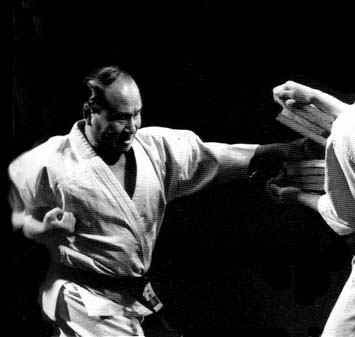

Tamashawari, Training in Karate by Steve Denoo





|
Remember, hard training is not recommended at all for those under 16 years of age. Those individuals under 18 years of age must get permission from a parent or guardian before starting training. Always consult a physician before beginning any exercise program. Train at your own risk. These training methods only reflect personal experience, cannot be held responsible for any injury resulting from attempting to train in these techniques.
|
For more information go here to: My Dictionary of Martial Arts Terms |
BreakingThis is a brief overview of the subject, for more information contact your instructor. There is no greater test of your technique and strength than breaking solid objects, usually wood, concrete, or rocks. It is a lot safer than injuring someone else, and much more moral. It only takes 12 pounds of pressure to break a bone, however because of muscles strength and the flexibility of the body it often takes more force.How much pressure does it take to break a bone, is the often asked question. Actually it takes a mere 12 pounds of pressure. The trick is the leverage, and the speed at which it is struck. As I like to point out, a bullet which weighs ounces kills faster than a bowling ball. Much has been written over the centuries about the training and development of such techniques. Some mistakenly believe that hardening the body alone is enough. It is only part of the training, but is not real Karate. My favorite text written on the technique comes from China and the thing called "Jing" the development and transfer of internal power. Transferring this power to the object can also be used to transfer it to the opponent. As soon as your chi (KI) is condensed inward toward the center of your body, the mind accelerates it and converts it into the energy needed. It feels like an electric current flowing and delivers a kind of electric shock. The development of this technique does not require the callus necessary to withstand the force of the blow. However it is not as much of a show, so the other is described below. But to become truly good and strong you also need to develop your Jing. Conditioning your knuckles develops a layer of callus to protect the hand and knuckle joints. Care should be observed because you have blood vessels running on the inside of the knuckle, and constant hard beating will damage the blood flow to your fingers. You can develop your callous by push-ups on the knuckles. It takes lots of push-ups, but you will not damage the hand. Once the callus has been established, then start other methods. I was given an interesting way of conditioning also that involved punching into the surface of water. It will also slowly build up the callus without damage, I later found it a Shaolin technique. I use it for Knife hand. I have since let my callus go, as my customers commented on how deformed it made my hands look. I let them go away, and have no damage to my hands today at all. I built my callus through push-ups and water punching. They were sizable before letting them go. I think of the way the Chinese taught most of their techniques. They taught modified techniques that worked, but not well, to those they did not want to know the secrets. How much of what we have been taught as iron hand are these techniques? A lot I believe from my study of the subject. Tai-Chi is a perfect example of how things were changed. Worthy of study. When preparing to break, your mind must concentrate on the underside of the board where the initial separation of wood fibers begins. If he boards have a bow in them, always place this upward or outward. Degree of difficulty is determined by resistance, less resistance occurs with spacers used in stacking boards. Then you are using penetration and speed to penetrate them all. More resistance is created when the boards touch each other as in the Oyama picture here. In this case speed, penetration and power must be developed to a greater degree. (see Special Training) When the boards touch each other resistance is greatly increased, and the total force must be multiplied by the number of boards used. 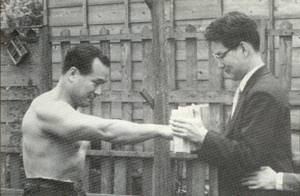
In order to perform properly, the mental preparation must be complete.
Before you start performing breaking techniques, you must understand the concept that produces the power of Karate. Some in an attempt to generate sufficient power, often think they must throw their shoulders into the punch. This is shown in lots of old movies and video, but is not right.
Stance is once more not to be overlooked, it tells you and shows you where your power is really coming from. It is one of the reasons isometrics are important to practice. For then you can feel where the strength is needed as you move about you get a proper perspective.  The abdominal muscles at the sides of the stomach, (External obliques) are key, as they pull the hip forward. The hip must be continually rotated back and forth to stretch the ligaments and tendons around these joints. Always begin with an object you know you can break. Your Sensei will help you in this. Based on your strength and technique he(she) has observed in class. Confidence is very important. So avoid advanced breaking until ready to do so.  It is very important to use the first two knuckles when hitting. Not only does it increase the force of the blow but, using the small knuckles can lead to ardiac problems in the future because of the exposed meridians.
It is very important to use the first two knuckles when hitting. Not only does it increase the force of the blow but, using the small knuckles can lead to ardiac problems in the future because of the exposed meridians.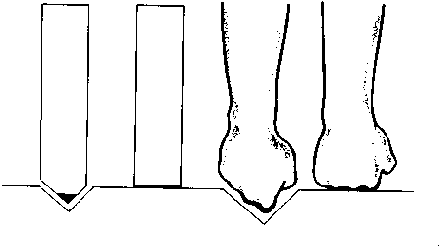  Palm heel and straight punch- The palm heel use usually the first technique learned because it is powerful and has the least chance of injury. The punch is advanced due to the hard bone contact and need for superior conditioning. Both of these weapons use the same thrusting movement. The only difference is the contact surface and how you hold your hand. Of course, you must make contact with only the first two knuckles (next to the thumb) when using the fist. People untrained in karate tend to make contact with either the last two knuckles or the entire hand. All you have to do is look at the size of the first two knuckles to realize that they are better for breaking. These two knuckles are also in line with the bones of the wrist and arm, providing the necessary support structure to absorb impact.
Palm heel and straight punch- The palm heel use usually the first technique learned because it is powerful and has the least chance of injury. The punch is advanced due to the hard bone contact and need for superior conditioning. Both of these weapons use the same thrusting movement. The only difference is the contact surface and how you hold your hand. Of course, you must make contact with only the first two knuckles (next to the thumb) when using the fist. People untrained in karate tend to make contact with either the last two knuckles or the entire hand. All you have to do is look at the size of the first two knuckles to realize that they are better for breaking. These two knuckles are also in line with the bones of the wrist and arm, providing the necessary support structure to absorb impact.
Pictured is Narve Laeret performing an elbow break.
Observe the standard dictates of karate punching for both the fist and palm heel. Utilize hip movement to add power to your strike. Remember to keep your elbow close to your side at all times in order to preserve linear movement. To help with this, just keep your arm so that it brushes against your side as you strike. The faster you move, the better your chances are of breaking. Above all else, make sure the movement you are making feels powerful. Everyone's structure is a little different. Guidelines are only there to help you find what works best for you.
Reverse Punch, Palm Heel, Hammer Fist, Knife HandThese are the most popular strikes used. The Reverse Punch is the best for speed and power, it demonstrates the most devastation of all techniques. To do this properly you must remember that there are 30 joints and 50 muscles in the hand, wrist, arm and shoulder used in its execution. Making a proper fist is vital to protect the hand and the small bones there. This is why knuckle push ups are vital. Unless you can do a minimum of 50, do not try breaking, you are weak. When practicing the moves do them slowly, so each muscle is trained properly. Remember to keep your shoulder down, raising it reduces your force. keep your back straight, elbow and arm close to the body and the angle of the forearm must be parallel to the ground in line with hand wrist and elbow, not at an angle, which also reduces force. Hips must be snapped into a wist motion in the direction of the target, this increases the force and speed. The back leg is then locked with the heel pushing into the floor. Most important is that the retracting arm. This is where the concentration is placed as if hitting someone behind you with your elbow. This causes greater force and speed. In the last tenth of a second the wrist is snapped over and locked into position. If the wrist is turned all along the way, the punch is weak, and greater strength must be used. Failure to do any of the above will lead to fractures of the hand or knuckle. This is preventable and stupid.
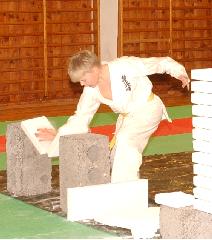 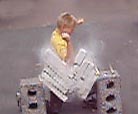 Pictured is Christoffer Laeret a fine example of the future in Kyokushin.
Tameshiwari
2. If the numbers of boards broken by the two contestants are equal, victory shall be awarded on the basis of the decision of the Supreme Judge. In this case, Tameshiwari requires more than three judges. 3. The main judge shall call out the contestants who shall bow to the front Although he may not touch the boards, the contestant may place a towel or cloth on top of them. 4. The main judge gives the signal for the breaking. If the contestant does not manage to break the boards at on time it shall count as failure. 5. As a rule, the tameshiwari must be performed only once without a repeat. However, the Head Judge and the assistant judges may agree to grant permission for a repeat. 6. The judge orders the successful contestant to sit down, then he announces the number of contestant, the number of boards successfully broken, or failure if such is the case. 7. The contestants who fail shall try one more time to break the boards. 8. At the conclusion of the judge's announcement, the contestants must stand, bow and leave the ring.
Pictured is Narve Laeret from Norway, in his record breaking 36 block break 28 January 2006 TAMESHIWARI (Breaking) RULES
2. Each competitor shall use four techniques in the breaking test, SEIKEN (fore-fist), SOKUTO (knife-foot), ENPI (elbow), SHUTO (knife-hand), the total number of broken boards will be the base on which Decision by Tameshiwari will be made on.
3. The Boards for the breaking test must be placed across the top of two stable blocks.
4. Each competitor must break a minimum of three boards. However, he may attempt to break as many boards as he likes.
5. The cloth on top of the boards shall have been approved of by the referee, and placed on the board by assistants.
6. The competitors are not allowed to move the blocks, however, they are allowed ot measure the distant.
7. The break is only approved of (KANZUI) if the boards are completely broken in two pieces. If they are only half broken it will be regarded as failure (SHIPPAI)
8. In case of SHIPPAI (failure) the competitor is allowed to try again, but the number of boards is limited to only three.
If the competitor fails the second attempt as well, the score of that attempt will be zero.
9. The TAMESHIWARI test will be held according to the referee's instructions. The time for breaking is set at two minutes. Overtime is considered as SHIPPAI.
After each break, the competitors shall move two steps counter-clockwise. |